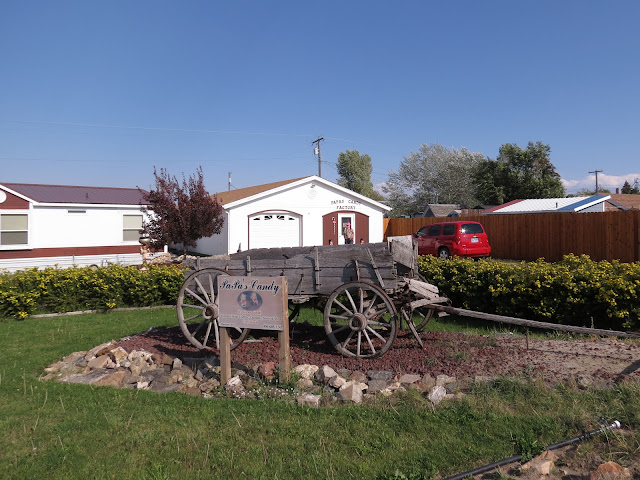Driving south through Montana we stopped at a rest area near a wildlife refuge. Scanning the hillside, this bison was easy to spot.
Birdie's good eyes picked up these 3 bull elk grazing farther up the hill.And near the ridge there were more.
From Butte we drove south on Route 2 and entered the Jefferson River Canyon.
An area of very old sedimentary rock. The dark "cave" on the left was a man-made limestone quarry.
Jefferson River, so named by Lewis and Clark who passed this way with Sacajawea in search of the Shoshone Indians.
Our destination was Lewis and Clark Caverns State Park.
Our first order of business was to find a post office to mail one of my hearing aids back for repair. My GPS said the closest one was in Pony, MT, about 12 miles away.
The first thing we noticed about Pony was, of course, the ponies.
This ranch gate caught our eye. The hats spun around in the wind.The Post Office was closing, but the postmistress did tell us there was a Post Office in Harrison, a town we passed through 6 miles back, that would be open another half hour. She did not have time to answer our questions about her town, so I looked it up on the internet. These next two pictures are from that site, as we had to get back to Harrison.
The town of Pony lies at the end of the paved road, hidden in the Tobacco Root Range of the Montana Rockies. Its population today is less than 100, but at the height of its gold-propspecting beginnings more than 5000 lived here. The gold mining area was discovered by Smith McCumpsey, a prospector known as "Pony" because of his short stature. He staked a claim in 1867, and a small mining camp known as Pony Gulch arose.
The twenty stamp mill was erected in 1883 by Henry Elling, a Virginia City, Montana entrepreneur who invested in land and mines in and around Pony. All that remains of the mill is the foundation and one side wall, constructed of stone.
Back to Harrison, this cute building was not the Post Office; it was the bank.
The Post Office is housed in the historic bank building. The postmistress here was most helpful, even helped package my hearing aid safely for travel. She also had some interesting stories to tell about the history of Harrison. The old bank vault is still here, and the postmistress found some very old and interesting bank documents left inside. She plans to turn them over to the local historical society if not claimed by the current owner of the building.
The old bank vault is still here, and the postmistress found some very old and interesting bank documents left inside. She plans to turn them over to the local historical society if not claimed by the current owner of the building.All this information whetted our appetite for more, and besides that, we were hungry. So when we noticed this creative sign for Papa's Candy, Birdie whipped right into the driveway.
Only in a small town will you see a note like this on the door of a business.
And sure enough, we found Tootie working on her beautiful raised-bed garden in the backyard.Hunting is important here, and most houses have antlers mounted. These form a cross.
After consuming several samples, we left Papa's Candy loaded down with more, but decided we ought to have dinner. So we stopped in at the local diner, "The Town Haul."
Inside, their menus gave us a little more history of the town and area.
We sat on their outside patio and ate a tasty hamburger made from locally raised beef.
This Collared Dove watched us eat.
By the time we returned to our campground, the smoke from area forest fires had settled into the valley, so we hunkered down inside for the night.
The smoke had cleared by morning, so the next post will be about the Lewis and Clark Caverns State Park.

























A great story. So interesting what you can find in some small towns.
ReplyDelete